
Contents





“Most Remarkable Rebellion”





Story · Written by Seong Hyekyung Photographed by Studio Kenn
Land Welcoming
the Morning
The last battle at Sabiseong Fortress was the conclusion to 700 years of Baekje’s history.
Sabi, meaning “dawn” in Korean, is now called Buyeo, which means “the morning has come.”
Just like its changed name, morning always comes after the dawn;
though the ancient kingdom fell and became a part of history, Buyeo still preserves its past and heritage.
Stepping outside the asphalt-covered cities, Chungcheongnam-do Province (in short Chungnam)
offers a connection to the soil that breathes with life.
Moving south along the Baekmagang River brings one to a fortress built around Busosan Mountain. Busosanseong Fortress in Buyeo-gun County helped protect Sabi, the old capital of the Baekje Kingdom (18 B.C.E.-660 C.E.). The fortress surrounding the mountain peak saw its construction begin in the 22nd year of King Dongseong’s reign (500 C.E.) and completion in the sixth year of King Mu’s reign (605 C.E.); it survives to this day. In the 16th year of King Seong’s reign (538 C.E.), when the Baekje capital was moved from Gongju to Buyeo, walls that included the valleys were built on the periphery of the fortress for more effective protection of the royal palace. The first structure that appears while passing through the mountain entrance is Samchungsa Temple. The temple enshrines three loyal vassals: Seong Chung, who spoke bluntly but frankly to correct the corrupt politics practiced by King Ui-ja and eventually died in prison after going on a hungry strike there; Heung Su, who stood by Seong Chung in criticizing the king and was ultimately exiled; and General Gye-baek, whose 5,000 troops bravely fought a 50,000-strong Silla Kingdom army led by Kim Yu-sin and who died in the Battle of Hwangsanbeol.
A forest path covered in the shade of trees leads to Banwollu Pavilion, which has a full view of the town of Buyeo-eup at a glance; Sajaru Pavilion to the west is where one can see the moon. A downhill path then begins, starting with the infamous Nakhwaam Rock. According to “The History of the Three Kingdoms,” the rock’s original name was Tasaam, meaning “a rock from which a person fell and died.” When the allied forces of Silla and China’s Tang Dynasty invaded the region, concubines and court ladies of Baekje chose to die with their kingdom by jumping into the river from atop Nakhwaam. This story of loyalty paid with the ultimate price gives the scenery of the Baekmagang River a bittersweet beauty.

The legend has it that drinking Goran Spring water made one three years younger with every cup.
The bottom of the cliff below Nakhwaam is where Goransa Temple, a branch of Magoksa Temple, is situated. Goransa has two mystical specialties—its spring water and herb—that are both mentioned in legend. Baekje kings are known to have enjoyed drinking the water that sprang from a crack on a rock in the back of the temple, dispatching people daily to fetch the water. A mystical grass known as Gorancho seemed to grow near the spring only; water fetchers usually put Gorancho leaves in their water buckets as proof that the water they carried was the bona fide spring water. Another legend has it that drinking Goran Spring water made one three years younger with every cup.
Heading over to Gudrae Dock, once a trading port of Sabiseong Fortress, enables a closer look at the river. Visitors can ride a yellow sailboat at the dock, which is now a sculpture garden. As they sail through gently flowing water, Busosanseong Fortress, Goransa Temple and Nakhwaam Rock all appear. Seeing these historical Baekje sites and scenes bring to mind the rise and fall of the ancient kingdom.
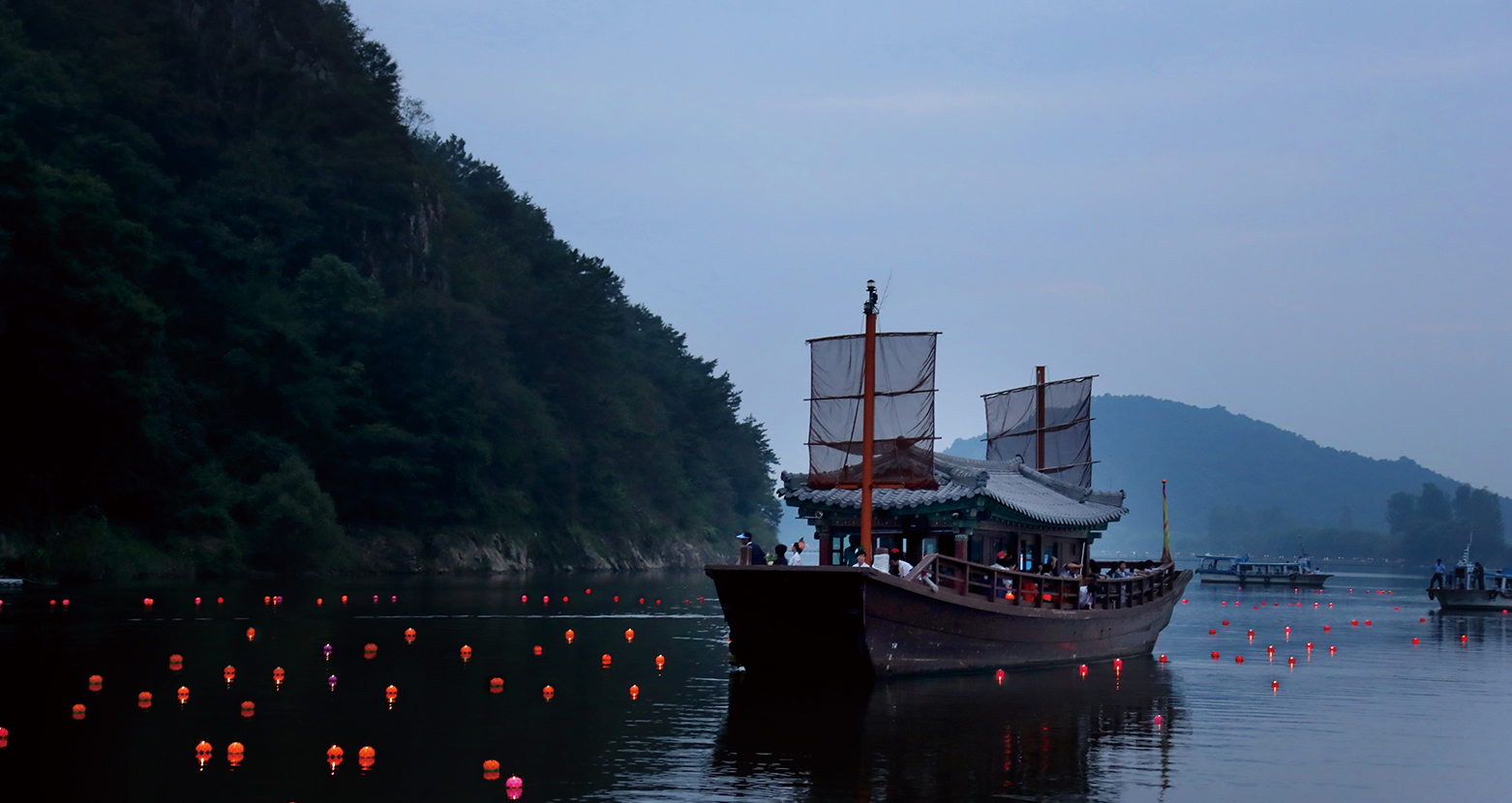
A boat taking passengers to Nakhwaam Rock features a unique shape that resembles a traditional Korean building. © BUYEO-GUN
In-Demand Filming Site
King Mu, the 30th king of Baekje, is a romanticized figure, a “boy who grew up collecting yams but sang ‘The Ballad of Seodong’ that allowed him to marry a Silla princess.” At the center of the story sits Gungnamji Pond. The last order the king gave before giving the throne to his son, King Uija, was for construction of an artificial pond. King Mu had the pond completed within the royal palace in the 35th year of his reign, and named it “Gungnamji,” meaning “south of the palace.” There, he planted lotuses and wild flowers. The stonework and willow trees that still stand in the middle of the pond show that an artificial island used to be there. The history of Baekje ends during the reign of King Uija, and to think that King Mu could have predicted that his kingdom would disappear is hard to imagine.
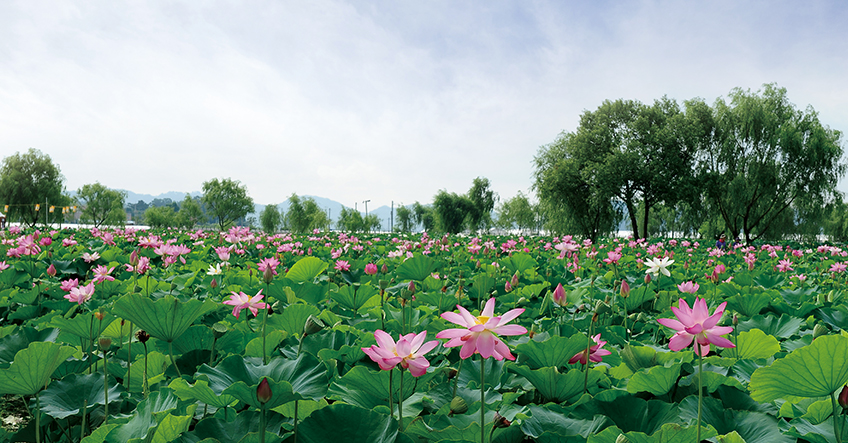
© BUYEO-GUN
Garimseong Fortress on Seongheungsan Mountain is a popular site for filming many historical dramas. The stone structure was built to protect Ungjin and Sabi, the two capitals of Baekje. Enormous and ancient-looking trees stand there appearing to guard the fortress. People call this zelkova serrata, a tree that is apparently 400 years old, the “Love Tree” since its appearance in the drama “The Ballad of Seodong” as the symbol of love between Princess Seonhwa and Seodong (King Mu). Looking at layers of low mountains, the slowly flowing Baekmagang River, and extensive and abundant fields evoke a sentimental feeling.
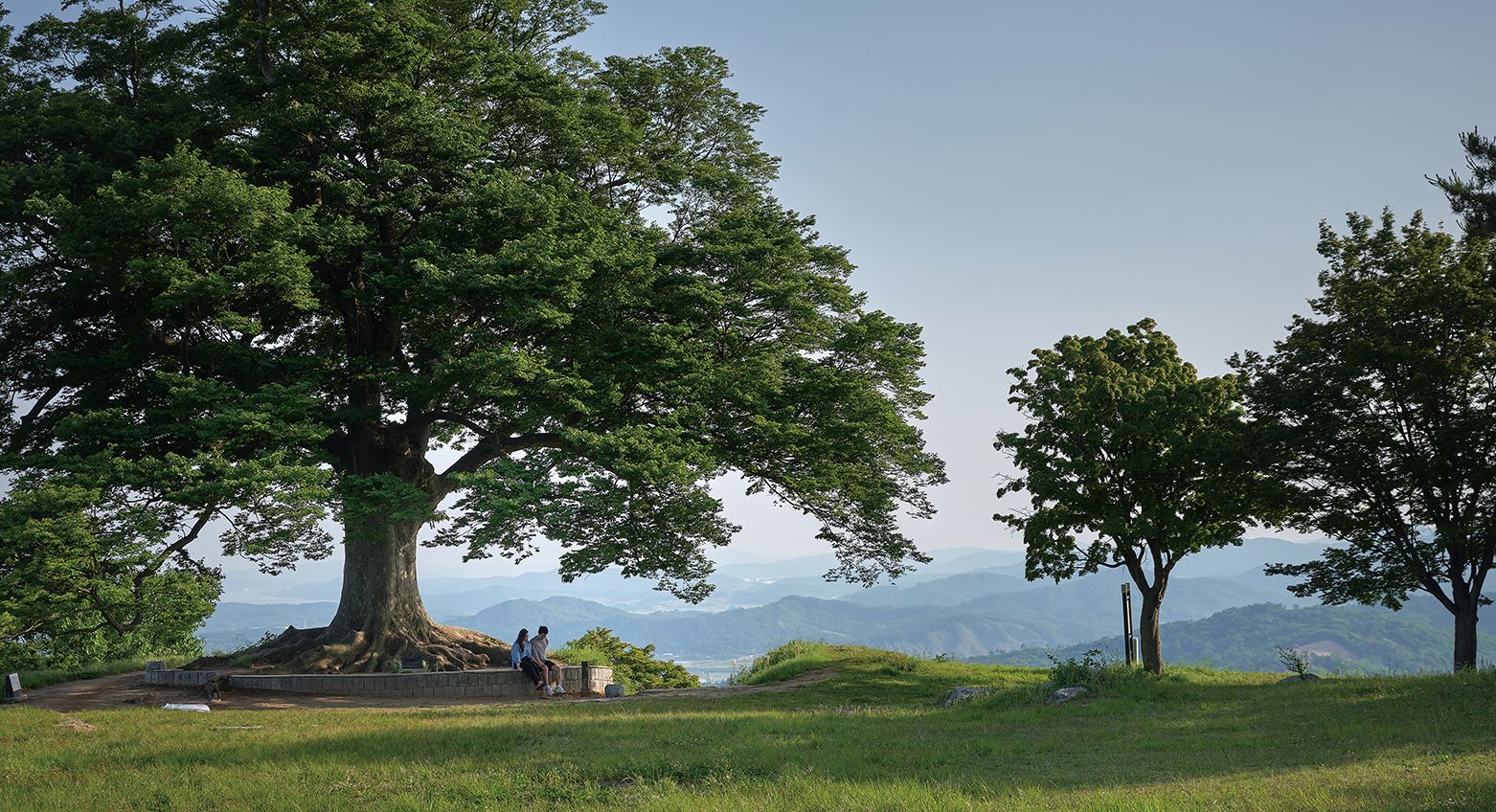
A couple is resting under the 400-year-old “Love Tree” on the top of Garimseong Fortress on Seongheungsan Mountain.
Sea of Life
The western region of Chungnam is a mudflat where land meets the sea. Seosan’s Garorim Bay, one of the world’s five most pristine mudflats, covers 15,985 hectares with a 162 km-long coastline.
This expansive bay and mudflat are home to more than 5,000 fishermen and their 2,000 households who make their living by catching squid, clams and oysters. They live in Jungri Fishing Village, which is famous for pristine mudflats and fresh seafood. A popular experiential program allows participants to catch and eat fresh seafood there. More than 100,000 tourists visit the area every year to try clam digging, sea trumpet collecting, net fishing and other fishing activities.
Stroll around the village along the vast Jungri mudflats to see the sun shine down on the glistening muddy surface. Elderly folks wearing rubber gloves and skillfully handling the objects they have unearthed and children searching for crabs in the mud and laughing are among the peaceful scenes here. Created by water and soil, this swampy land is great for seeing a variety of organisms.
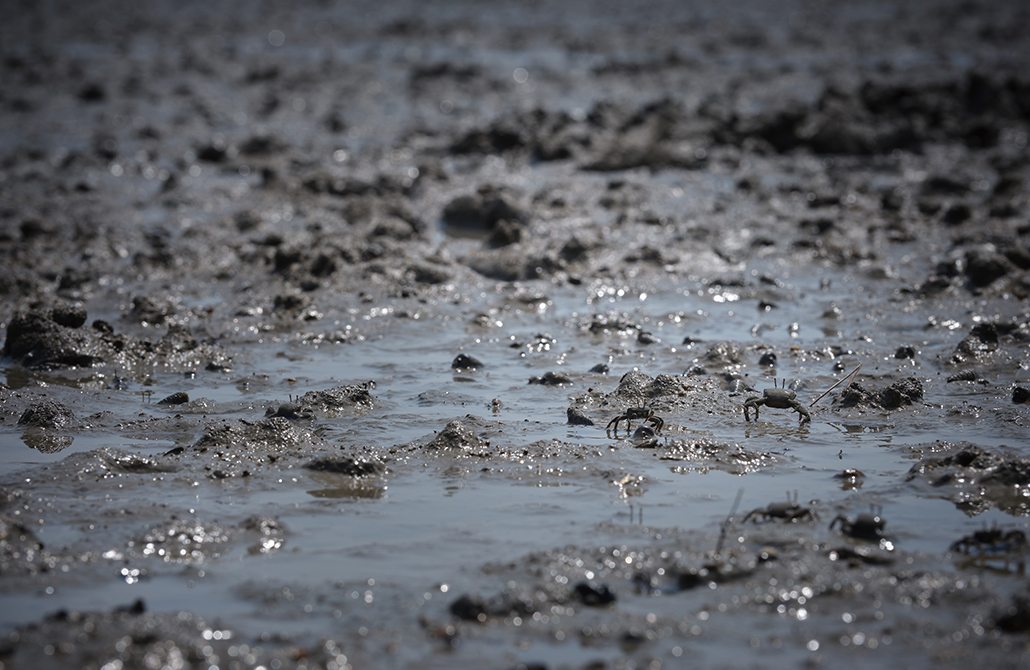 The mudflat is home to a variety of organisms.
The mudflat is home to a variety of organisms.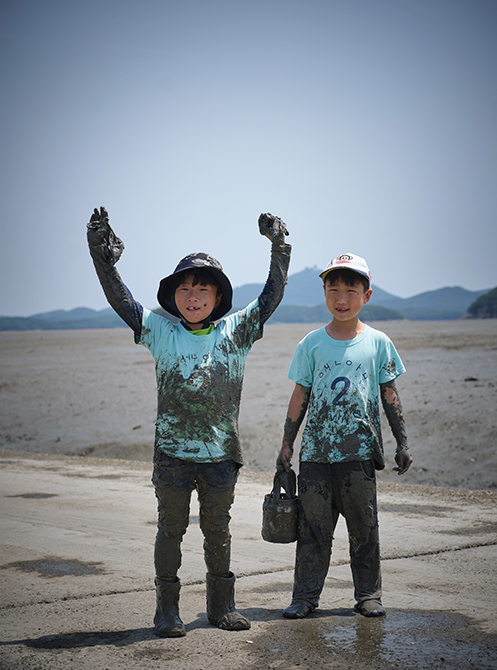 Children are excited to catch crabs in the mud.
Children are excited to catch crabs in the mud.Nature’s Way to Co-Exist
The shores of Taean-gun County welcome travelers with an appearance unlike that of Seosan. Sinduri Beach shows coastal sand dune’s rise and fall like the rolling dunes of a desert. A coastal dune is created by the accumulation of sand carried onto the land by sea currents and winds that eventually form a hilly landscape. The Sinduri Coastal Sand Dune, the only sand dune in Korea, is known to have been formed over 15,000 years ago. Accumulated through wind and moving seawater over time, the hills glow in various hues as the sun moves like a masterpiece. A variety of vegetation grows on the dune to give it a more dynamic and energetic feel: glehnia (beach silvertop), which can be used as a medicinal herb; lavender-colored beach morning glory; and Asian muraina grass, which raises sharp blades over the sandy ground. Mongolian racerunners and many other fauna inhabit this land as well. Because many of the biomes on the Korean Peninsula can be observed in this area, the dune is protected as a national natural heritage. Therefore, visitors cannot walk on the dune’s sand.
Behind the dune are flatlands and a mountain, and the freshwater backswamp called the DuWoong Wetland is formed on the boundary between the dune and the mountain. Despite its relatively small size, the backswamp is home to many plants and animals, including the indigenous species Korean golden frog living in an area surrounded by a green fence inside the swamp. The frog has a gold-colored belly that is hard to spot because of the creature’s low population and tendency to stay inactive. The period from late May to mid-June is the frog’s breeding season. Reptiles like the endangered Mongolian racerunner, amphibians such as the Eastern narrow-mouthed toad, and birds including the Chinese egret, grey heron, white-fronted goose, skylark and Kentish plover all call this place home. Living creatures co-exist by depending on one another. Though it may be invisible to us, new life is incessantly created in nature. That energy of life would probably be the message Chungnam’s pristine nature is whispering in our ear.
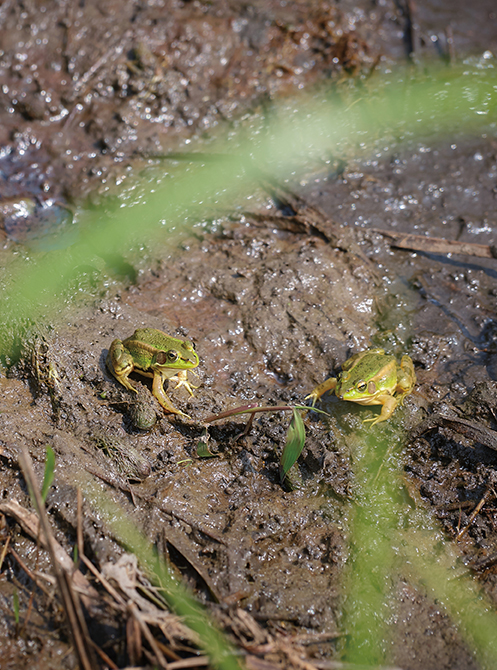 The indigenous species Korean golden frog inhabiting the west side of the Korean Peninsula is relatively immobile, moving only 10 meters a day.
The indigenous species Korean golden frog inhabiting the west side of the Korean Peninsula is relatively immobile, moving only 10 meters a day. Wind blows the fine sand of the Sinduri Coastal Sand Dune far away.
Wind blows the fine sand of the Sinduri Coastal Sand Dune far away.Other Articles





“Most Remarkable Rebellion”










